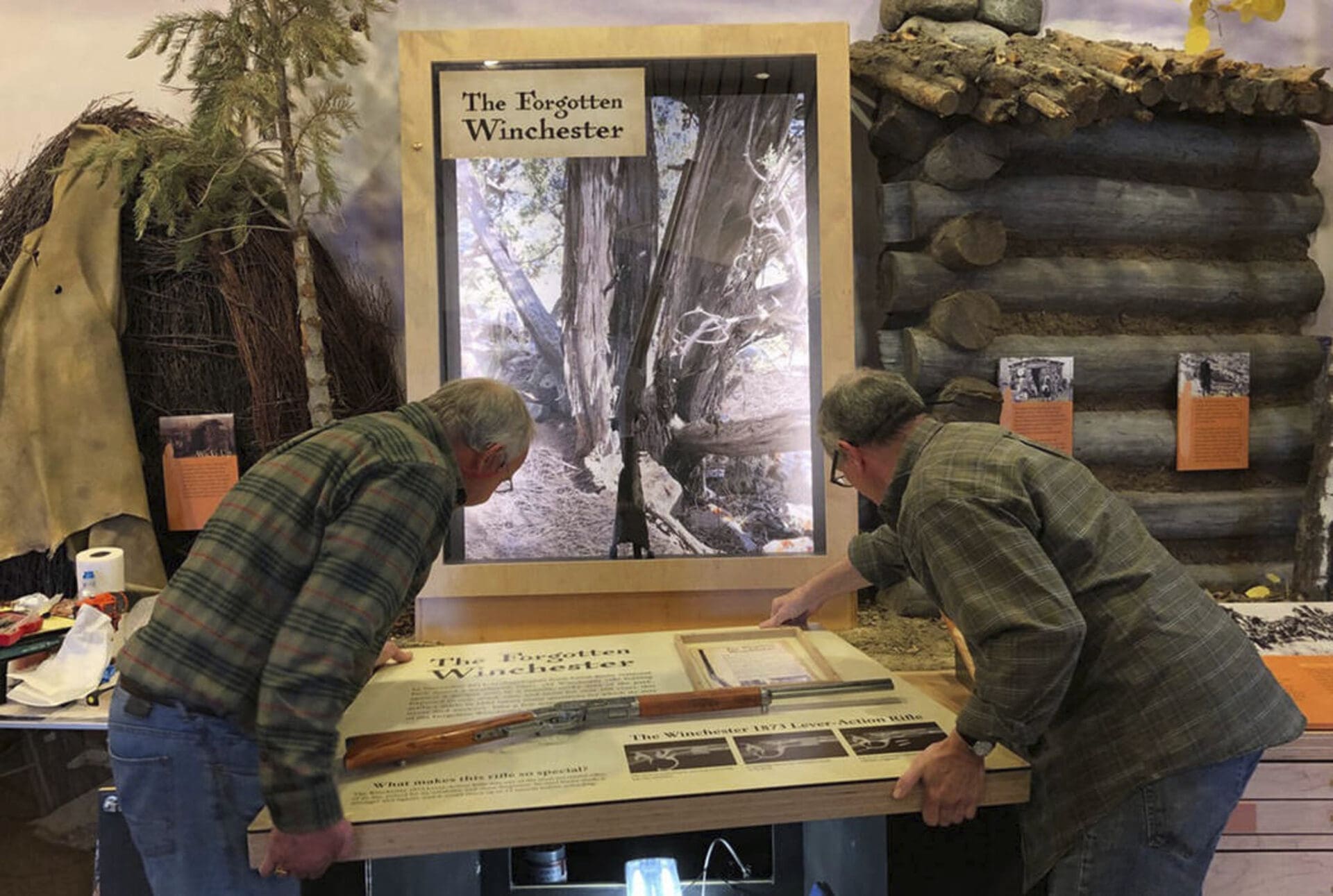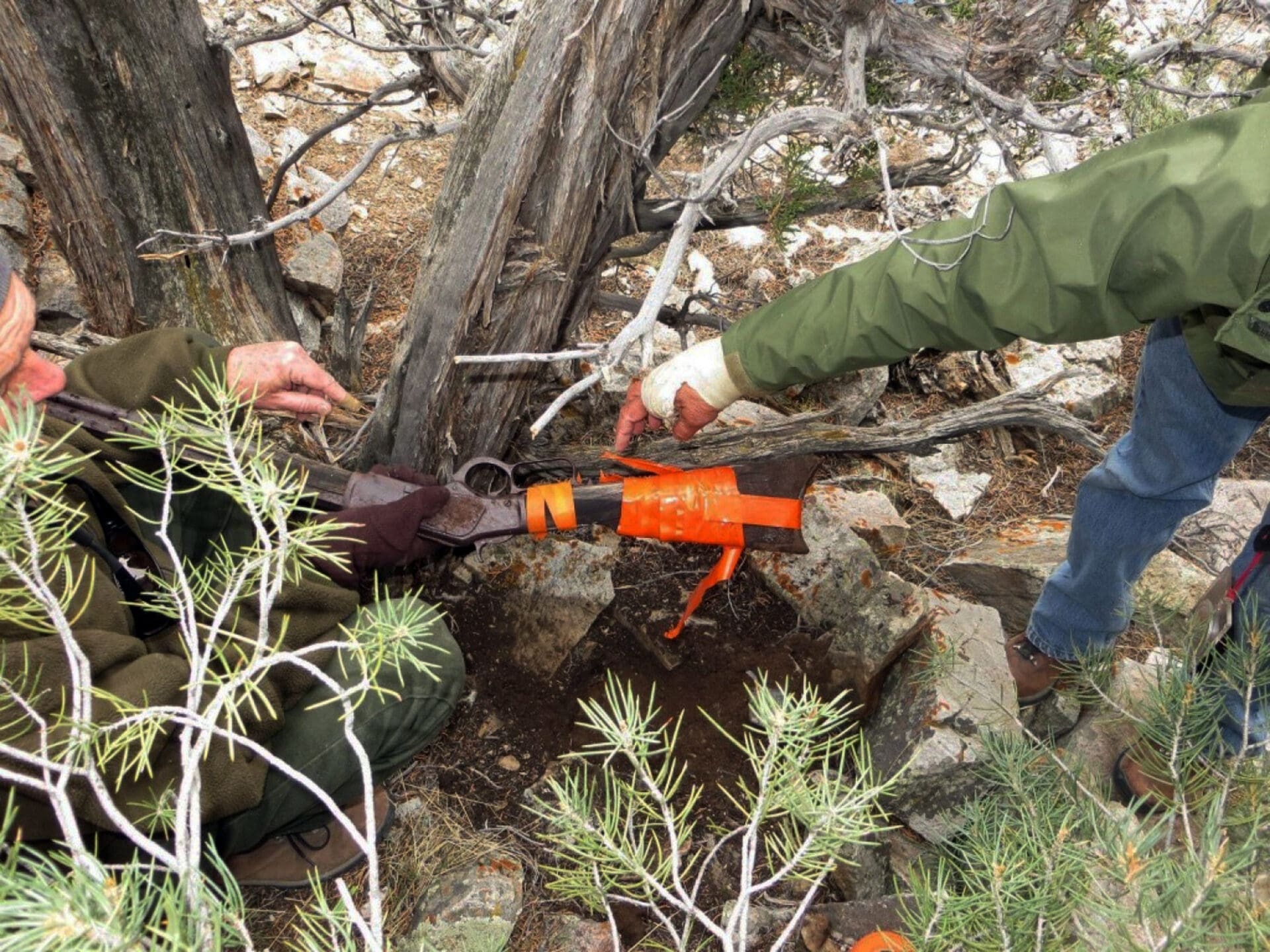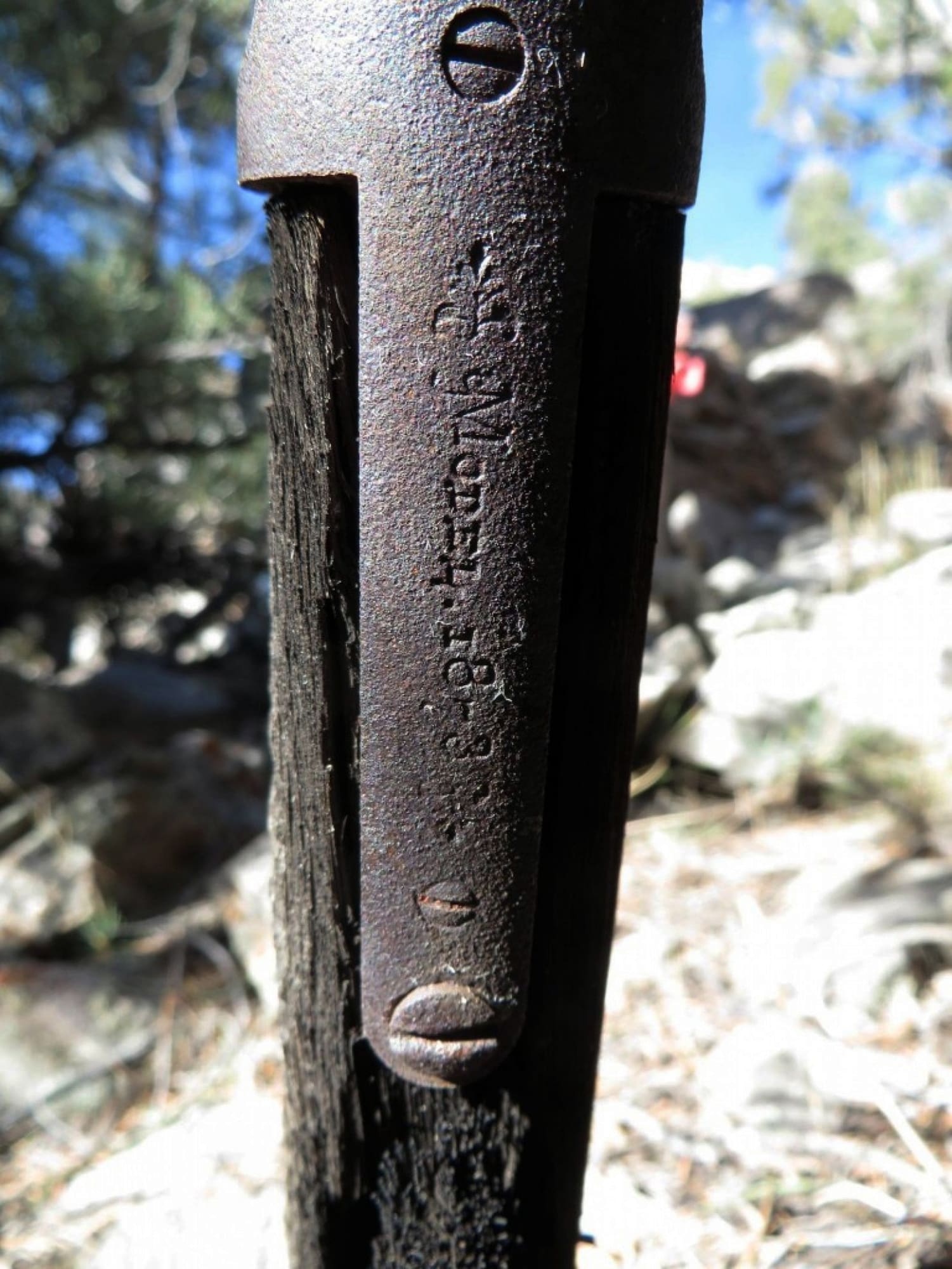
By Associated Press
A 137-year-old rifle found five years ago leaning against a juniper tree in Great Basin National Park in Nevada is now part of an exhibit dedicated to the “Forgotten Winchester” at the park visitor center near the Utah border.
The weathered Winchester Model 1873 is in a case designed to capture the way it looked when park archaeologist Eva Jensen stumbled across it on a rocky outcrop above Strawberry Creek during an archaeological survey.

Based on its condition, experts believe the weapon might have been abandoned in the forest more than a century ago.
But nearly five years after its discovery, park officials still don’t know who it belonged to or why it was left against the tree. No sales or ownership records have been found.

The serial number was visible, allowing experts at the Buffalo Bill Center of the West in Cody, Wyoming, to determine it was made in 1882.
The exhibit also highlights the role the Model 1873 — one of the most popular guns on the Western frontier — played in the history of the West.
“The exhibit is a showcase for visitors to discover the rifle’s mysterious story and become inspired to imagine, investigate and care about a piece of their American history,” said Nichole Andler, the park’s chief of interpretation.
Herbert Houze, former curator of a firearms museum at the Buffalo Bill center, has said Model 1873 rifles were so valuable that whoever owned the one on display might have rested it against the tree and been unable to find it later.
“You just don’t leave a gun like that there,” he said.
The rifles sold for $35 to $50 in the 1880s and can now fetch up to $15,000 depending on their condition.

The rifle on display has been exhibited at gun shows and at the Buffalo Bill center for a summer. There, officials did an X-ray, found a bullet in the stock and removed it.
The bullet is included in the new exhibit case.
“It has been a fun and inspiring project to work on with our park staff and our partners to complete this exhibit and give the Forgotten Winchester a permanent home,” Andler said.
The exhibit was designed and funded by the National Park Service, Great Basin National Park Foundation and Fund for People in Parks, a San Francisco Bay Area-based nonprofit that sponsors improvements at some of the West’s smaller, less famous parks.




In my youth I watched shows like the Lone Ranger. There was almost always a scene in these old serials were a bad guy would shoot his six gun empty, usually on the back of a galloping horse, and then throw it at the good guy. For a couple of years there I thought you could just wander around the west and pick up discarded Colts.
Turns out it was Winchesters.
We’ll probably never know what happened? Why was it abandoned? Or who left it there? Was it deliberate or just momentarily misplaced and despite the owner’s search, it was never found? Amazing condition for its age and a tribute to 19th Century gunsmithing.
It is difficult to convey to people just how dry the air is in central Nevada.
In that environment, the rifle would last a long, long time. Classic cars, farm equipment and airplanes last a long, long time in that environment. Things like rubber tires and seals don’t do well, but wood and steel last a long, long, long time there.
Imagine! A loaded weapon sitting there for 137 years, and it never killed anything. Not. One. Thing.
Just random luck, no critters wandered by before the rust set in and stopped it. Had it been on a good game trail or hiking path there’d be heaps of victimized fur bearing mammals.
Now had it been one of them damnable Glock’s of our era it’d of sprouted legs and gone hunting.
VERY SCARY!!!!
Thank God for all the gun laws uh……Otherwise it probably would of went on a mass shooting spree.
I would love to know the story behind this gun ……WOW……one can only imagine who/why this rifle was left behind and what happened to the owner.
The article says the bullet was found in the stock, which would indicate it was fired from some other gun at the guy holding this Winchester. Or did you mean it was found in the chamber/barrel and if the former was it the complete unfired cartridge? Something ain’t right about this. Some clarification is in order.
PS: Leave it to the AP to screw up a decent story. The /44-40 CARTRIDGE was unfired and was housed in a compartment in the buttstock.
Dan, perhaps you should have mentioned this instead of just cut and paste the AP story.
Hey, at least it wasn’t chambered in “.9 mm gauge.”
I thought that the “.9mm” was a myth until I was in several different Sportsmans Warehouse stores, above the pistols behind the counter is a sign proclaiming “.9 mm”. I know now that they must exist as I have spotted those signs in at least 4 different stores.
The .9mm is highly rivaled by the 40mm Glock I heard a salesman trying to sell a customer. He didn’t like it when I quipped that I wanted to see the size of the magazine for that critter. He didn’t throw me out but I had to leave to keep from busting out laughing……………
And from the CBS tv station in W. Palm Beach, Florida this wknd…
While reporting about the closing of southbound I-95 because of a shoot out involving the po-po and a bad guy: “…the man then got out of his truck and fired at officers with a Glock AR.”
How did I miss THOSE at the gun show?!
All they need to do to make that riful complete is some Lazer sights, a flashlight, a ventilated hand guard, a variable power scope a thing that goes up and a nice creosote job, reschamr it to 6.5 creedmoor. And get rid of that wood stock for crying out loud.
For those who have never been in the area, here’s how easily it could be lost:
Down on the flats, you’re in sagebrush from your knees to your hips, depending on the terrain and soils. You can see literally for miles (if your vision is good enough), and if you can spot a landmark to hike to, you can just work your way over there. If you dropped something out in the sagebrush, and you weren’t near-sighted, you could get back close to where you thought you previously were fairly easily.
But as you start up the slopes of the mountains, you encounter sparse (at first) and then thicker stands of pinyon pines and juniper trees, and your visibility might be cut down to about 100′ – if you’re standing in one of the herd paths or “lanes” that seem to naturally form in the PJ stands. If you’re in a thicker PJ stand, and they do get thicker on the east side of the state of Nevada, you might not be able to see more than about 50′.
Someone could have left that rifle, gone back to look for it, and they could have looked for a week without finding it if they didn’t have an above-average sense of memory. I’ve found all manner of tools and valuable hardware in the PJ stands whilst hunting in central/eastern Nevada – many of these tools over 100 years old. Given how short the season was to transit the Great Basin and get over the Sierras, I can see someone packing up and leaving the rifle behind.
Other places where well-preserved firearms have been found in Nevada: out near the “gates” – Eastgate, Middlegate, Westgate, then along the Pony Express Trail, and out in the Forty Mile Desert (which is south of I-80 between Lovelock and Fernley).
If you’re ever hiking or hunting in the Great Basin, I find that it helps to break out of the PJ stands and triangulate with a compass every so often, unless you have a GPS unit with you.
I’d say it came from one of the hands off the Sherman Ranch. I’ve watched a lot of Laramie reruns and Jess and Slim’s got saddled horses and thrown gunms scattered all over the place.
One of my “treasures” is an 1873 Winchester .44-40 with a full octagon barrel which I obtained for a great price at an auction in PA. Yes, it’s a “safe queen” – and will be for as long as I live and own it.
Did they searrch the area for bones of a possible owner?
There is still some surprises in the old West. What I want to find is a stash of Spanish gold. The legends are thick in the 4 corners. Just need to find me a nice tidy horde of pieces of eight.
Although an old Winchester would be nice.
Laying on a juniper tree, wow, for 150 years. So in 150 no grass or brush growed up around it ,no dirt nothing covered it up? , , , , , Around 14 years ago a guy caught a 124 flathead on a Zebco 202 , ten pound test line , gotta be true he’s in the books
The grounds in PJ stands are typically pretty barren of smaller plant life. Typically, there will be nothing but dropped needles, and maybe a couple species of forbs in PJ stands.
The trees grow very slowly, reaching a full expression of typically no more than 20 to 25′ in height. Once they reach this stage, they quit growing.
I had a red oak I planted on the Colorado prairie, up near Wyoming. Watched it for years. Would grow about 1.5″ every year, hahahahaha. Sometimes if it was really wet year close to 3″. Is why I went back home to Appalachia. One year I watched a sweetgum here put on 24″ in a single year. Water is a miraculous thing, hahahahaha.
In the same time frame I obtained a 38/40 M 1873 that was found under an old house in the Adirondacks {I got it from the finders}. After some TLC, mine now works. Have before & after pix.
Soil is not turning over there at the same rate. You can find all sorts of things in the arid West still if you go where no one else goes. My kids used to find all manner of bottles, keys, things that had lain for a hundred years in the same spot, because the ground isn’t swallowing up stuff in new leaf cover and detritus every year. I throw a bottle on the ground in Kentucky and come back next fall and it is half buried, two years later mostly gone, three and it’s part of the soil. The mountains here will swallow an entire car given a few decades.
Growing up out west, I have no problem believing this. The arid climate just doesn’t ruin stuff like a humid climate. And, the ground doesn’t change.
I am an old guy. Years ago we used to find old cartidges, tools from horse drawn wagons, arrow heads, all kind of stuff, just laying on the ground. Somewhat rusted, but still recognizable.
Arrow heads and busted pieces of pottery were real common finds. We would even occasionly find buttons that came from calvary uniforms.
Stuff like that was so common, we didn’t think anything about it and would just leave it be. I can’t help but think that we passed up some stuff would be valuable today.
I’ve found many of the same sorts of things, and know many people who have found many more such objects, laying on the surface, in obvious sight for anyone looking at where they’re walking.
People from back east refuse to believe the story so typical of these things: “I was out hunting/hiking/etc, looked down and there it was.”
People who hunt/fish/hike out west, however, know it is true, and they see it happen plenty of times.
When I was a kid in Colorado, we had some neighbors that had a hill on their property that was probably 300 feet tall, maybe 1/4 mile in width or so, not a very big hill. It was literally covered in arrowheads. The local story was that Indians chased a group of settlers and the settlers went up the hill. The arrowheads were from the Indians shooting up at the settlers. It was neat.
As kids we played “cowboys and indians” on that hill all the time. No telling what we trampled into the dirt under our feet running thru the sagebrush, or on our horses, not thinking anything about it.
My kids and I lived on the Colorado prairie for a number of years, very isolated, 60 miles out from any big town, and even as recently as 2010, they would find old .45-70 casings, turn of the century laundry bluing bottles, soda bottles from the 1930s and 40s with their labels almost perfectly intact, keys to old hotels in turn of the century styles – heck, they even once found most of a backpack-style fire extinguisher, the kind you filled with water, which we learned why that was there – for years we would keep an old pickup with a full water tank and sprayer ready to go by the house, the fires were so frequent. So there is still plenty out there. We moved on, though, as our historical research showed most of us have done for all of its history, hahaha. Couldn’t pay me to go back to current Colorado, no way.
That is one explanation so many arrowheads were found in one place, but another is that many tribes made them in assembly line fashion. Around here, in the Texas Hill Country, we often find groups of arrowhead together, often in various states of completion, from just such an activity.
Right around my house you’ll never find an arrowhead. Move just a bit up near one of the barns on the property and you’ll find them everywhere. But only there. On more than 800 acres on that side of the road, it’s the only spot we’ve ever found arrowheads. Oddly enough, we did find one large spear point, longer than a man’s palm and 2 1/2″ wide, in perfect shape, on the lawn of our dairy, near that same barn. It was made of what we call “Root Beer Flint” from the nearby Pedernales River, which gets it’s name from that same stone. What makes it odd is that dairy has been going continuously since 1974. People and livestock have walked over and around that spear point every day for all that time, including bringing heavy machinery in and out, and nobody every saw it. Then, one day, there it was, wrapped in the Little Blue Stem.
It’s a cool gun in a great display, but it’s not exactly news. It was in place when I visited Great Basin NP last June.
Of course, since it’s inside a federal building, you have to disarm yourself before you can see it.
Comments are closed.